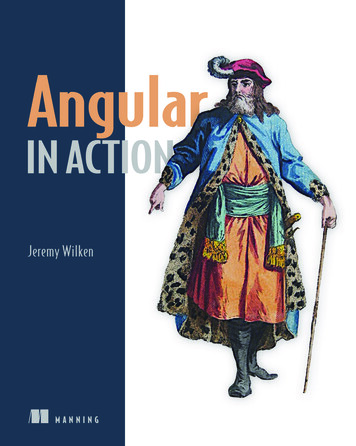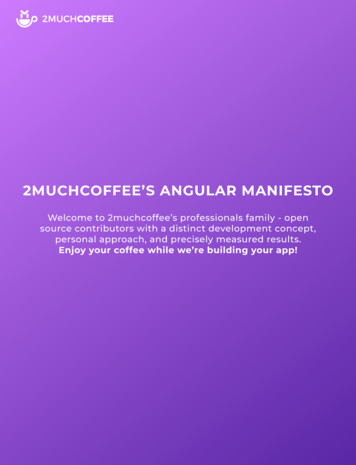
Transcription
Best Practices wefollowing inAngularDevelopmentwww.ideas2it.com
Angular is an open-source front-end framework developedby Google for creating dynamic, modern web applications.Introduced in 2009, Angular’s popularity is based on itseliminating unnecessary code and ensuring lighter andfaster apps. Having rapidly evolved from AngularJS in 2010,the front-end framework is today used by more than 40%of software engineers for creating user interfaces.Angular helps build interactive and dynamic single pageapplications (SPAs) with its compelling features includingtemplating, two-way binding, modularization, RESTful APIhandling, dependency injection, and AJAX handling.Designers can use HTML as template language and evenextend HTML’ syntax to easily convey the components ofthe application. You also don’t need to rely on third-partylibraries to build dynamic applications with Angular. Usingthis framework in your projects, you can reap multiplebenefits.While Angular Documentation is the right place to get toknow best practices, this document focuses on other goodpractices that are not covered in the framework’sdocumentation.2
1. Use Angular CLIAngular CLI is one of the most powerful accessibility toolsavailable when developing apps with Angular. Angular CLImakes it easy to create an application and follows all thebest practices! Angular CLI is a command-line interfacetool that is used to initialize, develop, scaffold, maintain andeven test and debug Angular applications.So instead of creating the files and folders manually, useAngular CLI to generate new components, directives,modules, services, and pipes.# Install Angular CLInpm install -g @angular/cli# Check Angular CLI versionng version3
2. Maintain proper folder structureCreating a folder structure is an important factor weshould consider before initiating our project. Our folderstructure will easily adapt to the new changes duringdevelopment.-- app -- modules -- home -- [ ] components -- [ ] pages -- home-routing.module.ts -- home.module.ts -- core -- [ ] authentication -- [ ] footer -- [ ] guards -- [ ] http -- [ ] interceptors -- [ ] mocks -- [ ] services -- [ ] header -- core.module.ts -- ensureModuleLoadedOnceGuard.ts -- logger.service.ts 4
-- shared -- [ ] components -- [ ] directives -- [ ] pipes -- [ ] models -- [ ] configs -- assets -- scss -- [ ] partials -- base.scss -- styles.scss5
3. Follow consistent Angularcoding stylesHere are some set of rules we need to follow to make ourproject with the proper coding standard.Limit files to 400 Lines of code.Define small functions and limit them to no morethan 75 lines.Have consistent names for all symbols. Therecommended pattern is feature.type.ts.If the values of the variables are intact, then declare itwith ‘const’.Use dashes to separate words in the descriptive nameand use dots to separate the descriptive name fromthe type.Names of properties and methods should always be inlower camel case.Always leave one empty line between imports andmodules; such as third party and application importsand third-party modules and custom modules.6
4. TypescriptTypescript is a superset of Javascript, which is designed todevelop large Javascript applications. You don’t have toconvert the entire Javascript code to Typescript at once.Migration from Javascript to Typescript can be done instages.Major benefits of Typescript include:Support for Classes and ModulesType-checkingAccess to ES6 and ES7 Features, before they aresupported by major browsersSupport for Javascript packaging and so onGreat tooling support with IntelliSense7
5. Use ES6 FeaturesECMAScript is constantly updated with new features andfunctionalities. Currently, we have ES6 which has lots ofnew features and functionalities which could also beutilized in Angular.Here are a few ES6 Features:Arrow FunctionsString interpolationObject LiteralsLet and ConstDestructuringDefault8
6. Use trackBy along with ngForWhen using ngFor to loop over an array in templates, use itwith a trackBy function which will return a uniqueidentifier for each DOM item.When an array changes, Angular re-renders the wholeDOM tree. But when you use trackBy, Angular will knowwhich element has changed and will only make DOMchanges only for that element.Use ngFor ul li *ngFor "let item of itemList;" {{item.id}} /li /ul ul li *ngFor "let item of itemList;" {{item.id}} /li /ul Now, each time the changes occur, the whole DOM tree will bere-rendered.9
Using trackBy function ul li *ngFor "let item of itemList; trackBy: trackByFn" {{item.id}} /li /ul button (click) "getItems()" Load items /button export class MyApp {getItems() { // load more items }trackByFn(index, item) {return index; // or item.id}}Now, it returns as a unique identifier for each item so only updateditems will be re-rendered.10
7. Break down into small reusablecomponentsThis might be an extension of the Single responsibilityprinciple. Large components are very difficult to debug,manage and test. If the component becomes large, breakit down into more reusable smaller components to reduceduplication of the code, so that we can easily manage,maintain and debug with less effort.Parent ComponentTitle ComponentBody ComponentList ComponentList ComponentList ComponentFooter Component11
8. Use Lazy LoadingTry to lazy load the modules in an Angular applicationwhenever possible. Lazy loading will load something onlywhen it is used. This will reduce the size of the applicationload initial time and improve the application boot time bynot loading the unused modules.Without lazy loading// app.routing.tsimport { WithoutLazyLoadedComponent } from'./without-lazy-loaded.component';{path: 'without-lazy-loaded',component: WithoutLazyLoadedComponent}With lazy loading// app.routing.ts{path: 'lazy-load',loadChildren: 'lazy-load.module#LazyLoadModule'}12
// lazy-load.module.tsimport { LazyLoadComponent } from './lazy-load.component';@NgModule({imports: [RouterModule.forChild([{path: '',component: LazyLoadComponent}])],declarations: [LazyLoadComponent]})export class LazyModule { }13
9. Use Index.tsindex.ts helps us to keep all related things together so thatwe don't have to be bothered about the source file name.This helps reduce size of the import statement.For example, we have /heroes/index.ts as//heroes/index.tsexport * from './hero.model';export * from './hero.service';export { HeroComponent } from './hero.component';We can import all things by using the source folder name.import { Hero, HeroService } from './heroes'; // indexis implied14
10. Avoid logic in templatesAll template logic will be extracted into a component.Which helps to cover that case in a unit test and reducebugs when there is template change.Logic in templates// template span *ngIf "status 'inActive' 'hold'" Status:Unavailable /span We can import all things by using the source folder name.// componentngOnInit (): void {this.status apiRes.status;}Logic in component// template span *ngIf "isUnavailable" Status: Unavailable /span // componentngOnInit (): void {this.status apiRes.status;this.isUnavailable this.status 'inActive' 'hold';}15
11. Cache API callsWhen making API calls, responses from some of them donot change frequently. In those cases, we can add acaching mechanism and store the value from an API.When another request to the same API is made, we get aresponse from the check, if there is no value available inthe cache then we make an API call and store the result.We can introduce a cache time for some API calls the valuechange, but not frequently. Caching API calls and avoidingunwanted duplicate API calls improves speed of theapplication and also ensures we do not download thesame information repeatedly.16
12. Use async pipe in templatesObservables can be directly used in templates with theasync pipe, instead of using plain JS values. Under thehood, an observable would be unwrapped into plain value.When a component using the template is destroyed, theobservable is automatically unsubscribed.Without Using async pipe//template p {{ text }} /p Using async pipe// template p {{ text async }} /p // componentthis.text observable.pipe(map(value value.item));17
13. Declare safe stringsThe variable of type string has only some set of values andwe can declare the list of possible values as the type. So thevariable will accept only the possible values. We can avoidbugs while writing the code during compile time itself.Normal String declarationprivate vehicleType: string;// We can assign any string to vehicleType.this.vehicleType 'four wheeler';this.vehicleType 'two wheeler';this.vehicleType 'car';Safe string declarationprivate vehicleType:'four wheeler' 'two wheeler';this.vehicleType 'four wheeler';this.vehicleType 'two wheeler';this.vehicleType 'car';// This will give the belowerrorType '"car"' is not assignable to type '"four wheeler" "two wheeler"'18
14. Avoid any typeDeclare variables or constants with proper types other thanany. This will reduce unintended problems. Anotheradvantage of having good typings in our application is thatit makes refactoring easier. If we had a proper typing, wewould get a compile-time error as shown below:interface IProfile {id: number;name: string;age: number;}export class LocationInfoComponent implements OnInit {userInfo: IProfile;constructor() { }ngOnInit() {this.userInfo {id: 12345,name: 'test name',mobile: 12121219
}}}// ErrorType '{ id: number; name: string; mobile: number; }' isnot assignable to type 'IProfile'.Object literal may only specify known properties, and'mobile' does not exist in type 'IProfile'.20
15. State ManagementOne of the most challenging things in softwaredevelopment is state management. State management inAngular helps in managing state transitions by storing thestate of any form of data. In the market, there are severalstate management libraries for Angular like NGRX, NGXS,Akita, etc. and all of them have different usages andpurposes.We can choose suitable state management for ourapplication before we implement it.Some benefits of using state management.It enables sharing data between different componentsIt provides centralized control for state transitionThe code will be clean and more readableMakes it easy to debug when something goes wrongDev tools are available for tracing and debugging statemanagement libraries21
16. Use CDK Virtual ScrollLoading hundreds of elements can be slow in any browser.But CDK virtual scroll support displays large lists ofelements more efficiently. Virtual scrolling enables aperformant way to simulate all items being rendered bymaking the height of the container element the same asthe height of the total number of elements to be rendered,and then only rendering the items in view.//Template ul cdk-virtual-scroll-viewport itemSize "100" ng-container *cdkVirtualFor "let item of items" li {{item}} /li /ng-container /cdk-virtual-scroll-viewport /ul // Componentexport class CdkVirtualScroll {items [];constructor() {this.items Array.from({length: 100000}).map(( , i) scroll list {i} );}}22
17. Use environment variablesAngular provides environment configurations to declarevariables unique for each environment. The defaultenvironments are development and production. We caneven add more environments, or add new variables inexisting environment files.Dev environment// environment.ts environment variablesexport const environment {production: false,apiEndpoint: 'http://dev.domain.com',googleMapKey: 'dev-google-map-key',sentry: 'dev-sentry-url'};Dev environment// environment.prod.ts environment variablesexport const environment {production: true,apiEndpoint: 'https://prod.domain.com',googleMapKey: 'prod-google-map-key',sentry: 'prod-sentry-url'};During the application build, the environment variables areapplied automatically from the specified environment file.23
18. Use lint rules for Typescriptand SCSStslint and stylelint have various inbuilt options, it forces theprogram to be cleaner and more consistent. It is widelysupported across all modern editors and can becustomized with your own lint rules and configurations.This will ensure consistency and readability of the code.Some inbuilt options in tslint: no-any, no-magic-numbers,no-debugger, no-console, etc.Some inbuilt options in stylelint: color-no-invalid-hex,selector-max-specificity, -after, etc.24
19. Always DocumentAlways document the code as much as possible. It will helpthe new developer involved in a project to understand itslogic and readability.It is a good practice to document each variable andmethod. For methods, we need to define it using multi-linecomments on what task the method actually performs andall parameters should be explained./*** This is the foo function* @param bar This is the bar parameter* @returns returns a string version of bar*/function foo(bar: number): string {return bar.toString()}We can use an extension to generate comments.TIP: 'Document this' is a visual studio extension thatautomatically generates detailed JSDoc comments forboth TypeScript and JavaScript files.a25
contact@ideas2it.com
Angular CLI is one of the most powerful accessibility tools available when developing apps with Angular. Angular CLI makes it easy to create an application and follows all the best practices! Angular CLI is a command-line interface tool that is used to initialize, develop, scaffold, maintain and even test and debug Angular applications.










